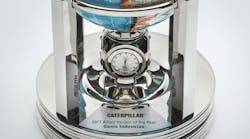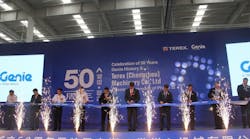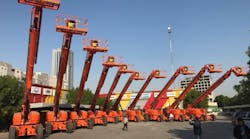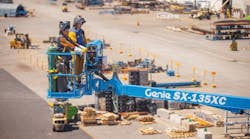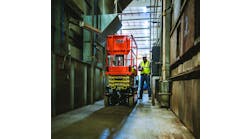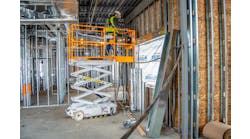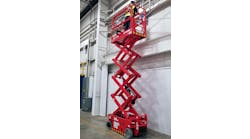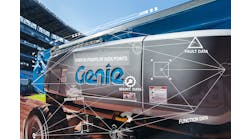RER sat down with Matt Fearon at The Rental Show to talk about the strength of the aerial market, the XC range of products, advances in manufacturing, growth in 2018, new safety programs and a whole lot more.
RER: What’s new in your Oklahoma City production facility?
Fearon: We put a bunch of investment there in anticipation of the market taking off and now it’s basically ramping production lines up, hiring the people and training them. Our Genie Certified Pre-Owned Program, which includes Genie Certified Reconditioning and Genie Certified Used, started there and that’s starting to kick up a lot more.
When you started Oklahoma City you probably thought “look at all the space” and now you might need to expand some more.
The way 2017 played out and the way 2018 is playing out, we’re always looking at what kind of capacity will there be the next three to five years. So there are capacity models that we’re looking at —there’s growth potential out there.
What are some of your new products?
We continue to expand our XC range of products, so that’s one of the main tracks of new products customers are going to see as we go through 2018. And the new standards have not been completely signed off and we’re timing it. We’ve shown four of the eight models that are being introduced and we’re going to time it. So soon it will be fully adopted and we’re ready to go, it’s just a matter of timing.
How are you finding the customers’ awareness of the ANSI standards?
It’s growing. We put the information on our website some time ago, showing here’s what’s coming, and here’s what it means to you, so I think there’s a growing awareness. It’s a lot like Tier 4. “It’s coming, it’s coming, it’s coming, oh, it’s here!” There’s an awareness that it’s coming but until it’s really here... I suspect it will ramp up.
Is the XC line being launched internationally?
Yes, it’s being launched globally, in fact, some models are ahead in Europe. We’ve actually put them out in Europe and they are very well received, there is definitely a demand. In markets like Europe, they’ve always had load sense requirements, calibration of the load sense system is much simpler on the new models so that they get it right away. These are people who have had load-sensing on their machines for a decade, maybe longer. There is definitely an appetite for technology that is greater over there than there is in the U.S. As they understand that the machine can do more work, they see the benefit.
How about the smaller chassis that you’re using on the 135?
It is global. Again in Europe in particular, they have the tighter streets and so the smaller chassis is very much appreciated.
What do you expect in 2018?
We see good things in 2018, we expect our revenue to climb about 10 percent year over year, which is fantastic. What we’re looking at is the fundamentals are healthy, the time utilization of the machines is great, rental rates were steady in 2017 and climbed through the year, which is really important, and then you add to that the used equipment market is improving as well. There is not a lot of used equipment out there so if you look at all the fundamentals we’re feeling really good about ’18. And also we talked the last few years about the replacement cycle and we’re feeling that now the replacement cycle is going to be an uplift to us. In 2018, ‘19 and ‘20, they’re going to be replacing the fleet that they bought in 2011 through 2014 and those were some pretty good growth years. So if you add that in it’s good.
As well as rental companies getting some depreciation benefits from the new tax bill.
Yes they can expense that right away, they don’t have to depreciate over a long period of time so that helps as well. And if we actually see some infrastructure money injected into the system, it would be even better.
Are lead times being extended?
A little bit on some products. Large rental companies came forward with orders early, they could see that the market was strong, which is great, because our rental partners are planning with us more. So if you look at our backlog at the end of the year, on December 31, our backlog was a record year-end backlog for Genie, so that’s a really good sign. As far as our production, we had better visibility transition from ’17 to ’18 than we did from ’16 to ’17, so we’re able to build some in advance. There are some products that the lead time has grown out but we always find a way. We have these big years but we have [better] production systems, we have our supply chains set up so we can ramp up quickly. There will be some lead times on some products, but I don’t think they will be terrible. Those are actually great problems.
Any new plans in the training and safety area?
We’ve got the Genie Lift Pro training, we continue to develop and deliver that to our customers. The idea is to make the training that we have accessible. It’s agnostic, the more training that is done the better. It’s our training or anybody else’s training, we’re trying to provide a new format that makes it easier to get the training out. One of the things that we’re doing is we have an end user group with large contractors, we’re talking to them and showing them the training that we have on aerial work platforms and the level of expertise that we have. They see that we can give them great training curriculum and we can actually do the training for them and set it up in “train the trainer” so yes we’ve got a pool for training.
Do you find the small independent still vibrant with new companies springing up?
Yes, they remain a very important part of our customer base. In my opinion, they always will. They find a way in niches, they have deep relationships with local contractors. There have been a lot of them purchased in the past few years, some of them resurface when their non-competes expire and they come back up, we’ve seen some of that. They are good operators and they have a place in the market.
What does the competitive landscape look like to you? Is it getting more crowded with more manufacturers?
Yeah, there are definitely more people coming in to the space. That speaks to the health of the industry. People look at it and see that the aerial work platform industry has growth potential because aerial adoption around the world is growing, there is a long way to go. So they naturally start coming out with products and they automatically are going to be looking at the big markets, such as North America and Europe. So yes, we are seeing more competitors. We realize that that’s both good and bad, we’re not intimidated by it. We have manufacturing all over the world, we have teams all over the world, we think we have years of expertise that some of these others don’t and our intent is to make sure that we stay ahead by using that global team, focusing on innovation, innovation that makes rental companies money. We have a very pragmatic approach to user technology, and where we decide to innovate. If you look at it closely, you’ll see that we are drawing a line of sight to where rental companies can get the rental ROIC.
Any new market segments or manufacturing?
In manufacturing, we continue to round out our global manufacturing footprint, we manufacture in North America, we manufacture in Italy, we manufacture in China, and we have taken a strategy of making essentially the same products, the same production systems in different parts of the world, and that’s been very successful, that’s been a real solid foundation for us. Our focus inside the factories is long term strategic planning around workforce and labor and as labor gets harder and harder to get, we are looking at automating more in our factories. You can see that in the form of more automated welding. We’ve always had automated welding but we’re expanding that out to more points on the machine, more AGBs, delivery of materials in plants, a lot of conveyance in and out of the factories.
I like the new mesh covering in your platforms. I wonder why this hasn’t been required for years.
That’s one that was a result of the end user group that we have with big contractors. We talked about “what other safety issues do we have out there?” People dropping bolts and tools from a long way up was a concern. The way rental companies look at it and the way end users look at it are different. Rental companies want to have a fleet that they can move out to any kind of job. The end users are more “what’s actually happening on the site?” So there’s a balance of getting there. So if we can make simple accessories that can go on a standard machine and solve those problems, that’s what we’re looking at.

